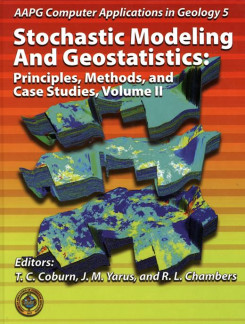Stochastic Modeling and Geostatistics
Since publication of the first volume of Stochastic Modeling and Geostatistics in 1994, there has been an explosion of interest and activity in geostatistical methods and spatial stochastic modeling techniques. Many of the computational algorithms and methodological approaches that were available then have greatly matured, and new, even better ones have come to the forefront. Advances in computing and increased focus on software commercialization have resulted in improved access to, and usability of, the available tools and techniques.
Against this backdrop, Stochastic Modeling and Geostatistics Volume II provides a much-needed update on this important technology. As in the case of the first volume, it largely focuses on applications and case studies from the petroleum and related fields, but it also contains an appropriate mix of the theory and methods developed throughout the past decade. Geologists, petroleum engineers, and other individuals working in the earth and environmental sciences will find Stochastic Modeling and Geostatistics Volume II to be an important addition to their technical information resources.
- Genre: All Books, Statistics & Geostatistics
Cast & Characters
Introduction—Looking Back and Moving Forward
Principles
Methods and Applications
Case Studies
Systems and Resources
| 3-10 | Geostatistics and Stochastic Modeling: Bridging into the 21st Century |
| 11-22 | Reflections on Geostatistics and Stochastic Modeling |
| 23-33 | A Virtual Conversation on the Impact of Geostatistics in Petroleum, Production, and Reservoir Engineering |
| 35-44 | Incorporating Secondary Information Using Direct Sequential Cosimulation |
| 45-58 | Modeling the Semivariogram: New Approach, Methods Comparison, and Simulation Study |
| 59-80 | Geostatistical Modeling of the Spaces of Local, Spatial, and Response Uncertainty for Continuous Petrophysical Properties |
| 81-90 | A New Method for Handling the Nugget Effect in Kriging |
| 91-108 | Feature-based Probabilistic Interpretation of Geobodies from Seismic Amplitudes |
| 109-122 | An Application of the Truncated Pluri-gaussian Method for Modeling Geology |
| 123-137 | Representative Input Parameters for Geostatistical Simulation |
| 139-150 | Sequential Simulation for Modeling Geological Structures from Training Images |
| 151-158 | An Efficient Approach for Quantifying the Uncertainty in Groundwater-model Predictions |
| 159-172 | Consistent Structural Model Simulations for Volumetric Uncertainty Study |
| 173-186 | Fractured Continuum Approach to Stochastic Permeability Modeling |
| 187-206 | A Comparison between Geostatistical Inversion and Conventional Geostatistical-simulation Practices for Reservoir Delineation |
| 207-219 | Full Integration of Seismic Data into Geostatistical Reservoir Modeling |
| 221-236 | Hierarchical Description and Geologic Modeling of a Braided-stream Depositional System |
| 237-252 | Three-dimensional Seismic Inversion and Geostatistical Reservoir Modeling of the Rotliegend Gas Field |
| 253-268 | Utility of Using Acoustic Impedance Data in the Stochastic Modeling of a Carbonate Reservoir |
| 269-278 | Brazos A-105 D-Sand Reservoir Modeling by Integration of Seismic Elastic Inversion Results with Geostatistical Techniques |
| 279-288 | Spatial Variability of Porosity in Chalk: Comparison of an Outcrop and a North Sea Reservoir |
| 289-299 | Modeling Complex Reservoirs with Multiple Conditional Techniques: A Practical Approach to Reservoir Characterization |
| 301-312 | Geostatistics: A Fast-response Tool for Reservoir Management |
| 313-324 | Process-based Knowledge Management: Overview and Application of Iterative 3-D Modeling Workflows |
| 325-328 | Bibliographic Resources for Geostatistics, Spatial Analysis, and Stochastic Modeling in Petroleum Exploration and Development |

